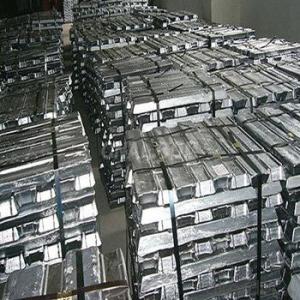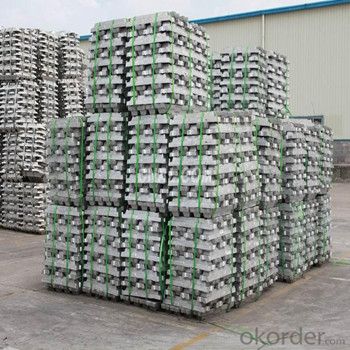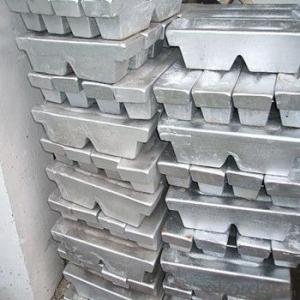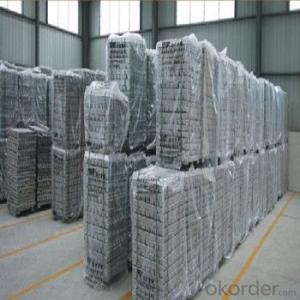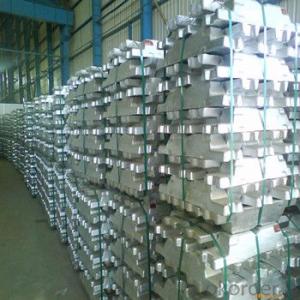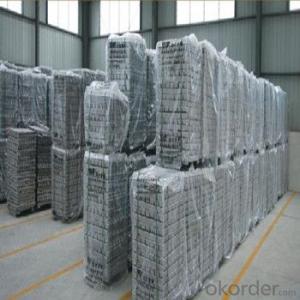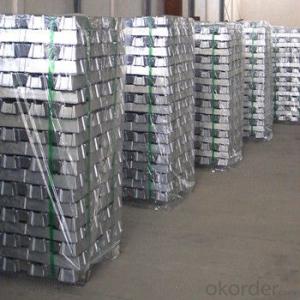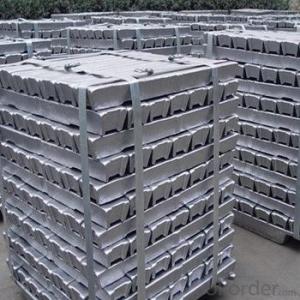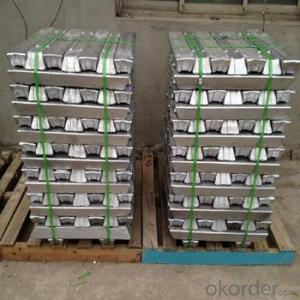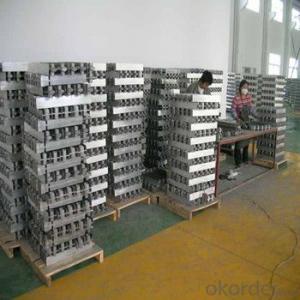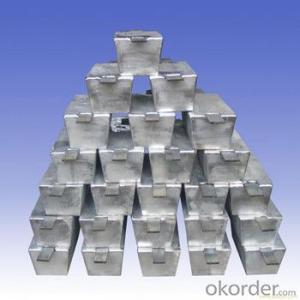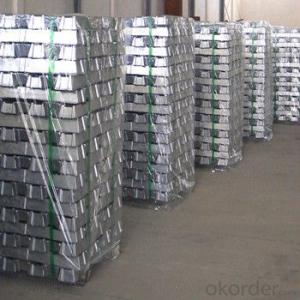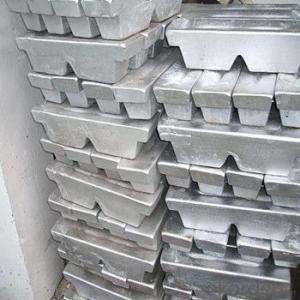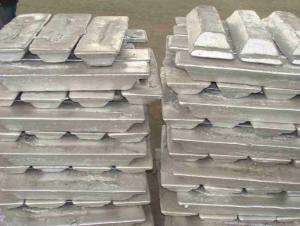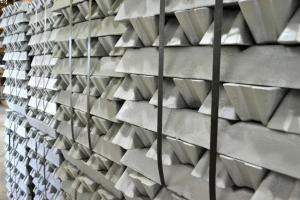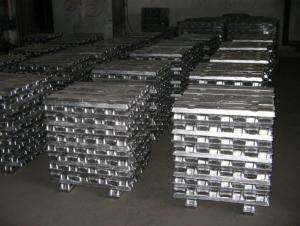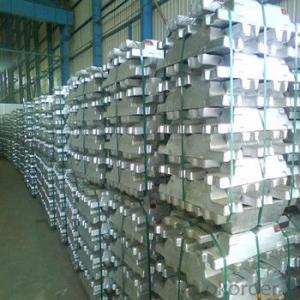Aluminum Pig/Ingot Popular Among Customers
- Loading Port:
- China main port
- Payment Terms:
- TT OR LC
- Min Order Qty:
- 1000 m.t.
- Supply Capability:
- 100000 m.t./month
OKorder Service Pledge
OKorder Financial Service
You Might Also Like
Pure Aluminum Pig/Ingot Used for Industry
1.Structure of Aluminum Pig/Ingot
A material that has been cast into a shape in order to be transported and processed easier than in an unprocessed form. An ingot is typically rectangular in shape, which allows it to be stacked. Ingots are most commonly associated with metals, with ingots of gold held in the vaults of banks and brokerages being popular images.
Aluminum Ingot is with the AL as the main chemical composition.Aluminum Ingot is used for industry,such as automobile,pinning and weaving,electron broadly and so on. Aluminum Ingot has the following advantages: easy control and operation, fast melting.
2.Main Features of the Aluminum Pig/Ingot
•High Purity
•Easy control and operation
•High strength
•Fast melting
•Competitive price
•Best Service
3.Aluminum Pig/Ingot Images
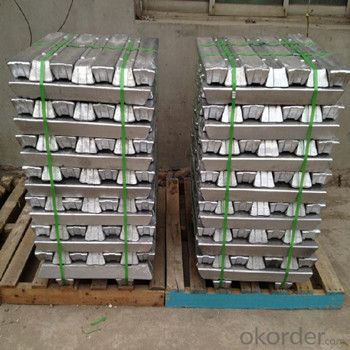
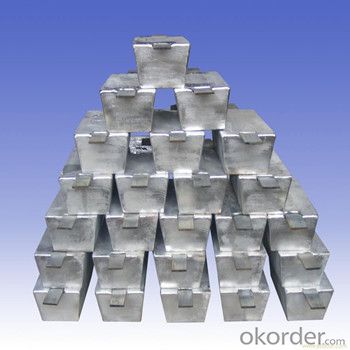
4.Aluminum Pig/Ingot Specification
Grade | Chemical Composition % | |||||||||
Al≥ | impurities ≤ | |||||||||
Si | Fe | Cu | Ga | Mg | Zn | Mn | others | Sum | ||
Al99.9 | 99.90 | 0.50 | 0.07 | 0.005 | 0.02 | 0.01 | 0.025 | - | 0.010 | 0.10 |
Al99.85 | 99.85 | 0.80 | 0.12 | 0.005 | 0.03 | 0.02 | 0.030 | - | 0.015 | 0.15 |
Al99.7 | 99.70 | 0.10 | 0.20 | 0.010 | 0.03 | 0.02 | 0.030 | - | 0.030 | 0.30 |
Al99.6 | 99.60 | 0.16 | 0.25 | 0.010 | 0.03 | 0.03 | 0.030 | - | 0.030 | 0.40 |
Al99.5 | 99.50 | 0.22 | 0.30 | 0.020 | 0.03 | 0.05 | 0.050 | - | 0.030 | 0.50 |
Al99.00 | 99.00 | 0.42 | 0.50 | 0.020 | 0.03 | 0.05 | 0.050 | - | 0.050 | 1.00 |
5.FAQ of Aluminum Pig/Ingot
We have organized several common questions for our clients,may help you sincerely:
①How about your company?
A reliable manufacturer & supplier of Aluminum Pig/Ingot,with many years’ experience in producing Aluminum Pig/Ingot.The items have beedn exported around the world,and have been acceptable among the customers,and have gotten the good reputation already.No matter from the quality,price and service,can be guaranteed for the cusgtomers.High purity and diffent grade are available.
②How to guarantee the quality of the products?
We have established the international advanced quality management system,every link from raw material to final product we have strict quality test;We resolutely put an end to unqualified products flowing into the market. At the same time, we will provide necessary follow-up service assurance.
③How long can we receive the product after purchase?
In the purchase of product within three wo We have organized several common questions for our clients,may help you sincerely:
- Q: How is an aluminum ingot made?
- An aluminum ingot is made through a process called smelting, which involves heating aluminum ore (bauxite) in a furnace until it melts and becomes molten aluminum. This molten metal is then poured into molds, where it cools and solidifies into the shape of an ingot.
- Q: How are aluminum ingots used in the production of electronic devices?
- Aluminum ingots are primarily used in the production of electronic devices as a material for creating casings and housings. The ingots are melted and shaped into desired forms, providing a lightweight yet durable structure for electronic devices such as smartphones, laptops, and tablets. Aluminum's excellent thermal conductivity also helps in dissipating heat generated by electronic components, ensuring optimal performance and preventing overheating issues. Additionally, the corrosion-resistant properties of aluminum make it a popular choice for protecting electronic circuits from external elements.
- Q: What is the weight of a standard aluminum ingot?
- The weight of a standard aluminum ingot can vary, but it is typically around 50 pounds (22.7 kilograms) or 25 kilograms.
- Q: How are aluminum ingots stored and transported?
- Aluminum ingots are typically stored and transported in various ways. They are commonly stored in warehouses or outdoor yards, where they are stacked on pallets or placed in racks. To ensure their safety, ingots are often stored in a dry and ventilated area to prevent corrosion and maintain their quality. When it comes to transportation, aluminum ingots are commonly moved using different methods. They can be loaded onto trucks, railcars, or shipping containers for long-distance transportation. To secure the ingots during transit, they may be wrapped in protective packaging materials or placed in crates or bins. Additionally, specialized equipment like forklifts or cranes are used to handle and move the ingots safely during loading and unloading operations. Overall, the storage and transportation methods for aluminum ingots prioritize their protection and efficient movement to their intended destinations.
- Q: What is the process for smelting aluminum ingots?
- The process for smelting aluminum ingots involves several steps. First, bauxite ore is mined and refined to produce alumina. Next, the alumina is dissolved in a molten cryolite bath within an electrolytic cell. An electric current is then passed through the bath, causing the aluminum ions to be reduced and deposited on a carbon cathode as molten aluminum. This molten aluminum is then tapped and transferred to a holding furnace. The impurities in the molten aluminum are removed through various purification processes. Finally, the purified molten aluminum is poured into ingot molds, where it solidifies to form aluminum ingots.
- Q: What are the advantages of the CNC process for aluminum and die cast aluminum?
- Aluminum processing, aluminum and other common such as screen. It is used extrusion process, that is, aluminum ingots and other raw materials in the melting furnace, after extrusion extruder extrusion die molding, it can also extrude a variety of profiles of different sections.
- Q: And aluminum liquid aluminum ingot related industries?
- The aluminum ingot process, also known as the metal aluminum process, is produced by directly passing the chlorine through the molten metal aluminum, which is directly contacted with each other. Aluminum production by AlCl3 has the advantages of simple process, less equipment, low investment unit. China's aluminum rich resources, the production of anhydrous aluminum chloride using basic aluminium ingot method.
- Q: How can I make a pop top aluminum ingot?
- Direct smelting into coarse aluminum ingot: the waste cans can be mixed in the smelting furnace, and finally a kind of metal ingot similar to the cooked aluminum is obtained. This kind of miscellaneous aluminium ingot is sometimes very pure in the market, which is very bad;
- Q: What are the quality standards for aluminum ingots?
- The quality standards for aluminum ingots are defined by various organizations and regulatory bodies to ensure the production of high-quality and consistent aluminum products. The following are some of the common quality standards for aluminum ingots: 1. Chemical Composition: The chemical composition of aluminum ingots is crucial in determining its mechanical properties and suitability for specific applications. Quality standards outline the acceptable ranges for elements such as aluminum, iron, silicon, copper, magnesium, and other impurities. 2. Purity: Aluminum ingots should meet specific purity requirements to ensure minimal impurities and contaminants. Standards typically set limits for impurities like oxides, alkali metals, and heavy metals to maintain the desired quality. 3. Physical Properties: Quality standards also cover various physical properties, including density, tensile strength, elongation, hardness, and thermal conductivity. These properties determine the ingot's performance in different applications and help manufacturers produce consistent, reliable aluminum products. 4. Grain Structure: The grain structure of aluminum ingots influences their mechanical strength and formability. Quality standards define the acceptable grain size and uniformity to ensure consistent properties within the ingots. 5. Surface Quality: The surface of aluminum ingots should be free from defects like cracks, voids, porosity, or excessive oxidation. Quality standards specify the acceptable limits for these defects to ensure the ingots' suitability for further processing. 6. Dimensional Tolerances: Standards also define the acceptable dimensional tolerances for aluminum ingots, including length, width, thickness, and weight. These tolerances ensure uniformity and compatibility with downstream manufacturing processes. 7. Packaging and Marking: Quality standards often include guidelines for appropriate packaging and marking of aluminum ingots to prevent physical damage, corrosion, or mix-ups during transportation and storage. It is important to note that specific quality standards may vary depending on the industry and intended use of the aluminum ingots. Manufacturers and customers should refer to relevant standards organizations, such as the International Organization for Standardization (ISO) or the American Society for Testing and Materials (ASTM), to ensure compliance with the appropriate quality requirements.
- Q: Ask the relevant matters you master the scrap aluminum ingot casting of aluminum, which is divided into several, if the recycled scrap aluminum ingot casting to join what!
- Aluminum, aluminum, raw aluminum, alloy aluminum, scrap aluminum smelting, aluminum ingot, common waste, such as teapot, refrigerator skin, aluminum pinch plate, that is, living aluminum.
Send your message to us
Aluminum Pig/Ingot Popular Among Customers
- Loading Port:
- China main port
- Payment Terms:
- TT OR LC
- Min Order Qty:
- 1000 m.t.
- Supply Capability:
- 100000 m.t./month
OKorder Service Pledge
OKorder Financial Service
Similar products
Hot products
Hot Searches
Related keywords
